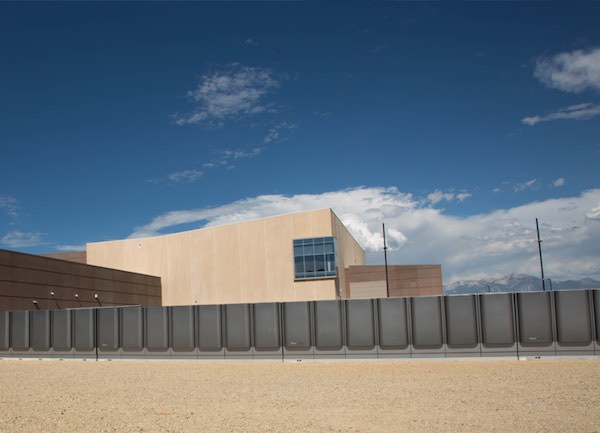
[Image above] A row of fuel cells in the foreground power an eBay data center near Salt Lake City, Utah. Credit: Bloom Energy
New research is fueling the future of fuel cells.
Fuel cells have long been idealized in clean energy futures for their ability to produce near-limitless, pollution-free energy. But in practice—as in many aspects of life—it’s not that simple.
There are various types of fuel cells that scientists, designers, and engineers have conjured up to get us the clean energy we’ve long dreamed about.
Proton-exchange membrane or polymer electrolyte membrane fuel cells (PEMFCs) are the current global leader in terms of commercial fuel cells, according to a Statista infographic. PEMFCs offer high power-to-weight ratios and low operating temperatures—making them particularly suitable for powering passenger vehicles, for example.
The next most commercially popular type of fuel cell, solid oxide fuel cells (SOFCs), can operate at much higher temperatures—enabling higher efficiencies and power capabilities—because they use a more stable electrolyte material: ceramic.
And a newer type of ceramic fuel cell called a protonic ceramic fuel cell (PCFC) also offers enticing possibilities.
Researchers are still working to optimize the performance of ceramic materials for fuel cells. But if current research is any indication, ceramics may be just the right materials to realize broad new possibilities for a clean energy future.
Pushing protonic ceramic fuel cells forward
Researchers at Northwestern University (Evanston, Ill.) have developed a protonic ceramic fuel cell fit for Goldilocks—it operates at just the right temperature of 500ºC to enable low-cost, high-efficiency power that could bring ceramic fuel cells to the forefront of the energy landscape.
The fuel cell operates at a mid-temperature range, a longstanding target for researchers developing fuel cells.
That’s because fuel cells that operate at higher temperatures operate more efficiently, but require materials that can take the heat—which aren’t cheap. But while fuel cells that operate at lower temperatures bypass that problem, they create a new one—they need expensive catalysts to speed up their otherwise inefficient reactions.
The Northwestern team, led by ACerS member Sossina Haile, attacked development of a mid-tempeature-range fuel cell from several angles.
“We solved multiple problems simultaneously by changing out the electrode, improving the electrolyte, and creating good contact and communication between the two materials,” Haile says in a Northwestern University news release.
For the electrode, the team used a double-perovskite cathode material with high activity called PBSCF (PrBa0.5Sr0.5Co1.5Fe0.5O5+δ). Joining that material with a stable electrolyte called BZCYYb4411 (BaZr0.4Ce0.4Y0.1Yb0.1O3) provided just the right fit of high power density and stability at an intermediate operating temperature.
The scientists also found that another problem that has plagued previous fuel cells was poor contact between the electrode and electrolyte, which slows down ion migration from one electrode to the other.
So they manufactured a solution using pulsed laser deposition to lay down a thin interlayer between the two. According to the paper’s abstract, “We deposit a thin dense interlayer film of the cathode material onto the electrolyte surface to mitigate contact resistance, an approach which is made possible by the proton permeability of PBSCF.”
Although the fix improves ion migration, however, its cost is a detriment to scaling up manufacture of the fuel cells. According to the release, the team is currently investigating ideas to reduce costs.
The paper, published in Nature Energy, is “Exceptional power density and stability at intermediate temperatures in protonic ceramic fuel cells” (DOI: 10.1038/s41560-017-0085-9).
Searching for novel solid oxide fuel cell materials
And researchers at the University of Wisconsin–Madison are harnessing the power of computation to identify better materials for SOFCs.
Using quantum mechanics-based computational techniques, the researchers have identified 52 potential cathode materials from a screen of more than 2,000 candidate perovskites.
“If you can find new compounds that are both stable under the operating conditions of the fuel cell and highly catalytically active, you can take that stable, highly active material and use it at a reduced temperature while still achieving the desired performance from the fuel cell,” lead author Ryan Jacobs says in a University of Wisconsin–Madison news release.
To find highly catalytically active materials, the team modeled which compounds have high activity in catalyzing oxygen reduction reactions. But that’s more tricky that it seems, because the complex reaction is difficult to computationally model.
According to the release, the team overcame this roadblock by using using another parameter that’s correlated with catalytic activity, but is much easier to calculate, as a proxy.
Of course, it’s important to note that this work is purely computational, although it provides a good pool of compounds for future research to focus on.
“With this research, we’ve provided specific recommendations of promising compounds that should be explored further,” Dane Morgan, UW–Madison materials science and engineering professor and senior author of the research, says in the news release. “Some of the new candidate cathode materials we identified could be transformative for SOFCs for reducing costs.”
The research, published in Advanced Energy Materials, is “Material discovery and design principles for stable, high activity perovskite cathodes for solid oxide fuel cells” (DOI: 10.1002/aenm.201702708).
Did you find this article interesting? Subscribe to the Ceramic Tech Today newsletter to continue to read more articles about the latest news in the ceramic and glass industry! Visit this link to get started.

